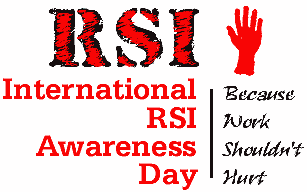 What is RSI?
What is RSI?
Repetitive strain injury (RSI) is an umbrella term for a number of overuse injuries affecting the soft tissues (muscles, tendons, and nerves) of the neck, upper and lower back, chest, shoulders, arms and hands. Typically arising as aches and pains, these injuries can progress to become crippling disorders that prevent sufferers from working or leading normal lives.
Why International RSI Awareness Day?
Repetitive strain injuries are a serious occupational health concern across the world. February 28, 2007 will mark the eighth annual International RSI Awareness Day.
RSI Day is an opportunity to promote injury prevention and raise awareness about the prevalence of RSIs and their effects. Workers forced to do monotonous, repetitive jobs, who work too long or too fast without enough breaks, are affected by RSIs. Poor work organization (unnecessary overtime, cutbacks and layoffs, substandard equipment, lack of worker control) contributes to RSIs. By using the principles of ergonomics (where work should suit you, rather than you suiting work), we can re-design tools, work stations, workplaces and work organisation to reduce the risk of workers getting hurt.
Held on the last day of February, it is the only "non-repetitive" day on the calendar and is officially observed on February 29th. Unions, workers support groups and others around the world mark International RSI Day each year.
Victoria
Statistics
In 2004 – 2005, there were 14,107 WorkCover claims for sprains and strains injuries. Total claims were 30,489. Payments for sprains and strains claims since 1985 have totalled $8.203 million. Payments for injuries to wrist and fingers in the same period have totalled $1,479million.
In Victoria, RSI Awareness Day highlights the need for:
- Improved manual handling regulations and
- More prosecutions to compel employers to implement controls to prevent workers suffering RSIs
WorkSafe has released 'Proposed Occupational Health and Safety Regulations 2007' for public comment. (declared July 2007).
Manual Handling is dealt with in the consolidated regulation as one of many OHS hazards and has specific duties relating to hazard identification, control of risk and review of risk control measures. What is missing is more detail on how the Section 28 duties of designers of buildings or structures in the OHS Act 2004 applies to ensure that hazardous manual handling tasks can be eliminated in workplace design and redesign. Studies have shown that design contributes significantly to serious work–related injury. The reduction of MSD risk by modifying equipment and processes after they have been introduced into a workplace is difficult and expensive. The most cost effective and efficient stage at which to control risk is the design stage. For example, redesign of shelving in a workplace can eliminate repetitive movements, bending and stretching.
There have been very few prosecutions for breaches of manual handling laws since in the last two decades. According to WorkSafe, the last prosecution arising from a manual handling injury occurred over a year ago, in January 2006. While the company, Woolworths, was fined $100,000, there are thousands of workers being injured and WorkSafe is not prosecuting the employers responsible.
Australia
Whilst WorkSafe could do better for Victorian workers by prosecuting employers, an increasing number of Victorian workers are going to find themselves worse off. The Howard government has been approving the transfer of workers out of the state system into the commonwealth OHS and compensation system.
With a total of only 3 prosecutions (for anything) for the whole of Australia in 2005 – 2006, it is not likely that there will be any meaningful protection for workers offered by the federal government under the 'Comcare' system.
Over 340,000 workers will be covered by Comcare by mid March.
On February 28th take action by bringing hazards to the forefront to have RSI and all forms of muscular disease and injury recognized for the disabling condition that it is.
Actions
-
Do the Quiz that you can download from the top of the page . It's easy to do and can be a great way to get some talk started on any parts of your work that are causing sprains and strains.
-
Elect an OHS Rep (and deputy) in your workplace, if you haven't already got one or more. If it's been a while since you negotiated DWGs and elected reps, check out whether the current arrangement still suits.
More Items
-
International RSI Day 2008
Friday February 29, 2008 is International Repetitive Strain Injuries Awareness Day...read more
-
International RSI Day 2009
It's that time of year again - International RSI Awareness Day...read more
-
International RSI Day 2010
This Sunday, 28 February, tell the Victorian government to "Get serious" about RSI! A national Model Manual Handling Regulation is being developed - but all signs currently are that it will take us backwards!...read more